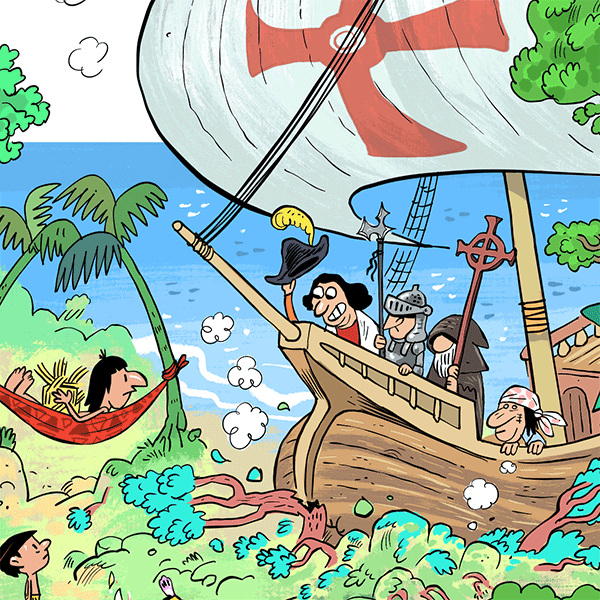Exploration has always been essential to human nature. The desire to answer the question “Hey! What’s over there?” is what drove the first humans off the plains of Africa.
From there they traveled to the Middle East, then Europe, Asia, America, and everywhere else humans exist today. This curiosity and drive to see what’s on the “other side” has sent humans into space, touching the moon and someday Mars and beyond.
This is because new lands promise food, safety, freedom, riches, and so much more.
In the 14th century, improvements in shipbuilding and navigation made it possible for Europeans to sail long distances and to make connections with parts of the world they didn’t even know existed, changing the entire course of human history along the way.
Two Continents Collide
For the vast majority of human history, the very large Pacific and Atlantic Oceans kept people from different continents separate from one another.
Greed, population growth and social unrest encouraged Europeans to sail the world during the 15th, 16th, and 17th centuries. Today, this period is called the European Age of Discovery.
The term discovery is somewhat controversial when we talk about it now. The lands Europeans “discovered” already existed and were populated by millions of people.
Looking to the Sea
The European Age of Discovery starts with a desire. A desire to get rich by finding a new trade route from Europe to Asia.
Asian goods were hot commodities in medieval Europe.
Europeans loved Persian fabrics, Chinese silk, Indonesian spices, and Indian salt, to name a few. In Asia, people were more than willing to accept European cotton and grain, as well as gold and silver.
This vast trade network connecting Europe and Asia is known as The Silk Road. Throughout history, the Silk Road has seen its ups and downs. However, to move goods over land between Europe and Asia took a long time and involved lots of people. Everyone helping out had to get paid somehow, and this drove up the cost of goods. Many Europeans longed for a way to access these goods at lower prices.
The Race Begins: Portugal Looks to the Sea
In the early 15th century, around 1410 AD, the third son of King John I of Portugal, Henry, began financing voyages further out into the Atlantic as well as along the coast of Africa. He encouraged his father to conquer existing cities on the African coast, such as Ceuta in present day Morocco, as a means of establishing overseas trade routes.
The success of this initiative inspired Henry to send additional missions down the coast of Africa. This initiated a wave of “exploration,” leading the Portuguese to be the first ones to sail around the southern tip of Africa and reach India.
In many ways, they had “done it,” meaning they had found an alternate route to Asia. But it was still a long and difficult journey. Others hoped there was an even easier way.

The Rest of Europe Joins the Party
Portugal launched a race to find new routes to India and the rest of Asia. And with such tremendous profits at stake, people were willing to take chances.
Perhaps the most famous of these efforts came in 1492 AD.. During that year, a Genoese merchant named Christopher Columbus set sail from Spain heading due west. He had convinced the Spanish king and queen, Ferdinand and Isabella, that he could reach India going that way.
Columbus has actually first asked the Portuguese king to fund his trip. But they laughed him away. Ferdinand and Isabella, on the other hand, said “what the heck?” and sent Columbus on his way.
Columbus reached land after six weeks at sea. He’d made it to India, but soon realized he hadn’t. Instead, he’d “found” land previously unknown to Europeans.
This turned the race to find a new route to Asia into a frenzy. The Spanish, English, French, Dutch, Swedish, Norwegian, and Russian governments all started sending people out in the world to see what was out there.
As they did, they started forming colonies, spreading their culture and customs around the world and giving a never-before-seen boost to international trade.
Written by Matthew Jones
Illustrated by Jean Galvao
